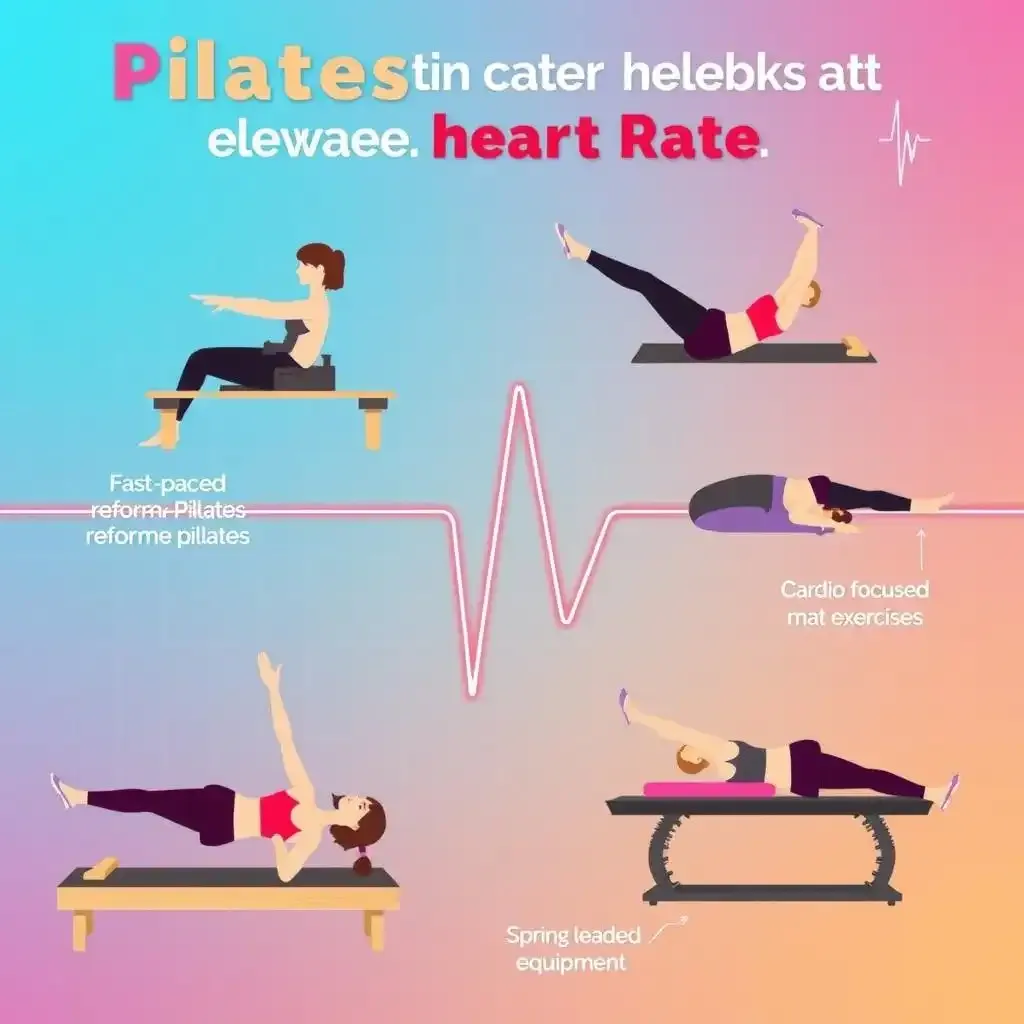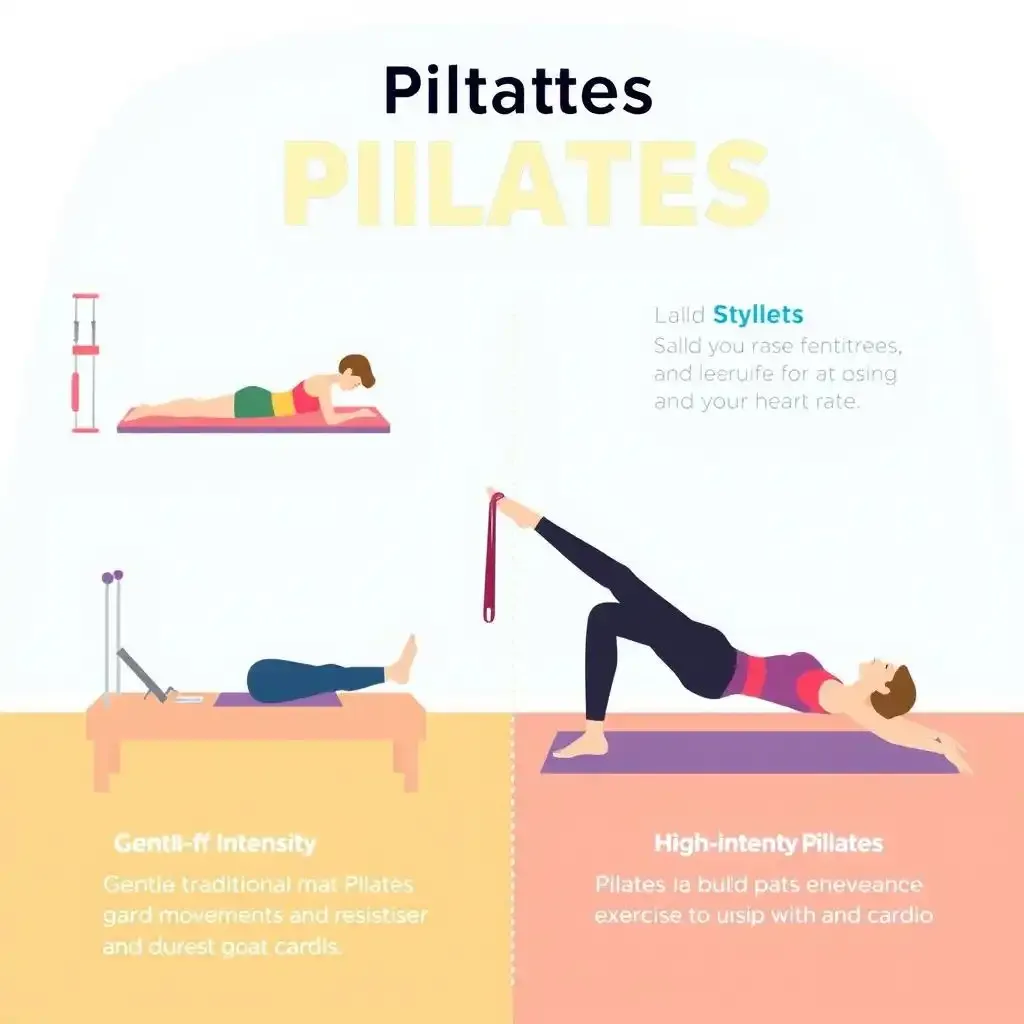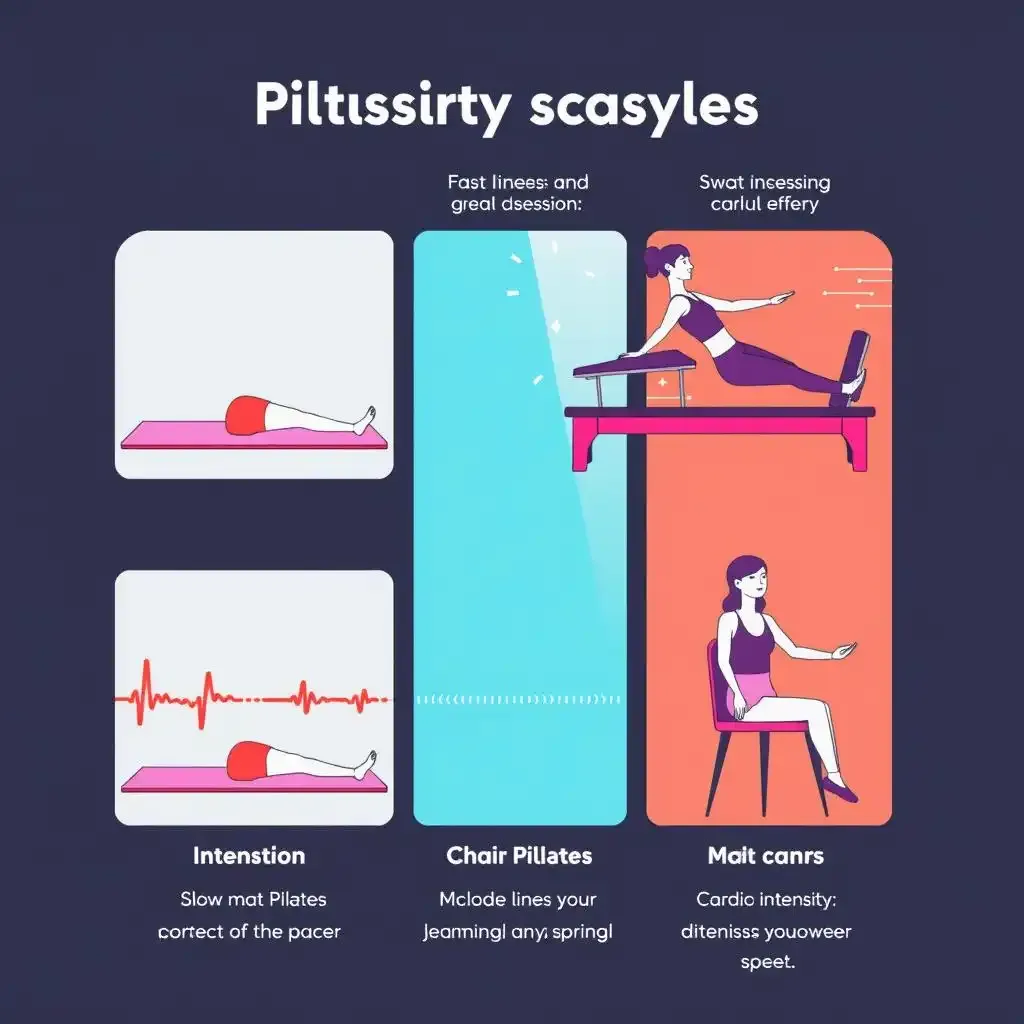Table of Contents
So, you're wondering: is pilates cardio? It's a question many fitness enthusiasts grapple with. Pilates, known for its focus on core strength and controlled movements, often gets pigeonholed as a purely strength-training activity. But the truth is a little more nuanced. At kizworld, we're here to explore the fascinating relationship between Pilates and cardio, examining whether it can genuinely contribute to your cardiovascular health and fitness goals. We'll investigate into the intensity levels needed to reap cardio benefits, explore the surprising ways Pilates boosts your metabolism, and discuss how best to incorporate Pilates into a well-rounded fitness routine. Get ready to uncover if Pilates can become your secret weapon for a healthier, stronger you!
Question | Answer |
|---|---|
Is Pilates cardio? | It depends on the intensity and type of Pilates performed. High-intensity Pilates can provide cardio benefits. |
Does Pilates improve cardiovascular fitness? | Yes, high-intensity Pilates can significantly improve cardiorespiratory fitness. |
Is Pilates enough cardio on its own? | Probably not for most people aiming for significant cardio improvements. Combining it with other cardio is often recommended. |
What are the benefits of Pilates as a cardio workout? | Improved cardiorespiratory fitness, increased metabolism, and full-body conditioning. |
How can I make Pilates more cardio-focused? | Increase the speed and intensity of movements, choose exercises that enhance heart rate, and incorporate interval training. |
Is Pilates Cardio? The Amazing Truth!
Is Pilates Cardio? Debunking the Myths
Pilates: Strength Training, Not Cardio? Think Again!
Okay, let's get one thing straight: a lot of people think of Pilates as just stretching and strengthening. They visualize slow, controlled movements, and that's totally true for some Pilates styles. But that’s only part of the story! Think of it like this: a leisurely stroll in the park is definitely not the same as sprinting a marathon. Both are forms of movement, but they engage your body in very different ways. Pilates, done at a higher intensity, can absolutely get your heart pumping.
I've seen it with my own eyes! My friend Sarah, who's super into Pilates, started doing reformer Pilates classes that incorporated bursts of faster, more dynamic movements. She went from feeling like Pilates was just a chill workout to actually feeling breathless and energized. It's all about how you approach the exercises. Want to learn more about how Pilates can help with your core? Check out our guide on getting abs with Pilates.
Pilates Type | Cardio Intensity | Heart Rate |
|---|---|---|
Traditional Mat Pilates | Low | Slightly elevated |
Reformer Pilates (fast-paced) | Moderate to High | Significantly elevated |
Chair Pilates (dynamic) | Moderate | Moderately elevated |
The Heart of the Matter: Intensity Levels
The key to understanding if Pilates is cardio for *you* lies in intensity. Traditional Pilates, with its focus on precision and control, is more of a strength-building activity. Your heart rate might increase slightly, but it's not a major cardiovascular workout. It's like carefully crafting a beautiful sculpture – precise and deliberate, but not exactly a race against time. However, if you crank up the speed, add resistance, and incorporate more dynamic movements, Pilates can become a serious cardio challenge.
Think about it like this: a slow, gentle bike ride is relaxing, right? But if you suddenly start cycling uphill at a super fast pace, your heart will be pounding! Pilates is similar. You can adjust the intensity to suit your fitness level and goals. Want to know more about how to maximize calorie burning during your Pilates sessions? Check out our detailed article on Pilates and calorie burning.
- Increase the speed of your movements
- Use resistance bands or other equipment
- Incorporate interval training (short bursts of high intensity followed by rest)
Beyond the Beat: Other Cardio Benefits of Pilates
Even if you don't push yourself to a full-on cardio sweat fest, Pilates still offers indirect cardiovascular benefits. The increased muscle strength and improved posture you gain from Pilates can actually improve your overall fitness, making other cardio activities easier and more enjoyable. It's like giving your body a tune-up before a big race – you'll perform better because you're stronger and more efficient.
Think of all the tiny muscles Pilates engages – your core, your back, your glutes. Strengthening these muscles improves your body's efficiency, which means you'll burn more calories even when you're not actively exercising. Plus, improving your posture, something Pilates excels at, can make breathing easier, which directly impacts your cardiovascular system. If you're curious about how Pilates can help your mental wellbeing, you can read our article on Pilates and mental health. It's a total body workout, not just for your muscles!
Is Pilates Cardio? Debunking the Myths
Pilates for Cardio: A Surprising Workout?
Pilates: It's Not Just for Strength!
Hey there, fellow fitness fans! Let's chat about Pilates and cardio. You might think about Pilates as all slow, graceful movements, and yeah, that's definitely *a* part of it. But think of it like this: a gentle stroll is different from a sprint, right? Both are walking, but one gets your heart pumping way more! Similarly, Pilates, done with a bit more pep in your step, can totally be a cardio workout. I've seen it firsthand – my friend, after switching to a more energetic Pilates class, was totally winded in a good way! It’s all about upping the intensity.
Want a sneak peek into how to really get the most out of your Pilates sessions? Check out our tips on . You might be surprised at how effective it can be!
Pilates Style | Cardio Level | Great For... |
|---|---|---|
Traditional Mat Pilates | Low | Building strength and flexibility |
Reformer Pilates (fast-paced) | Moderate to High | A serious cardio challenge |
Chair Pilates (dynamic) | Moderate | Improving endurance and coordination |
Boosting Your Heart Rate: The Intensity Factor
The secret to Pilates as cardio? It's all about how hard you work! If you're doing traditional Pilates, you'll feel a good stretch and some muscle burn, but your heart rate won't skyrocket. That's fine if you're aiming for strength training. But if you want to boost your cardiovascular fitness, you need to increase the intensity. Try faster movements, add some resistance bands, or even try interval training – short bursts of intense work followed by brief recovery periods. It's like adding turbo boosters to your Pilates practice!
Still have questions about the best ways to get the most out of Pilates? We've got you covered with our comprehensive guide on Pilates effectiveness. It’s a total game-changer.
- Speed up your movements.
- Use resistance bands or weights.
- Try interval training (high intensity followed by rest).
Beyond the Obvious: Unexpected Cardio Perks
Even if you don't turn your Pilates session into a cardio marathon, you still get some awesome cardiovascular benefits. Think about it: Pilates builds serious core strength. A strong core helps with posture, balance, and overall body efficiency. This makes other activities, like running or swimming, easier and more efficient. It’s like giving your body a performance upgrade. Plus, better posture means better breathing, and that directly impacts your heart and lungs. It's a sneaky way to get your cardio on!
Worried about hurting yourself during Pilates? Check out our article on avoiding injuries in Pilates to ensure a safe and effective workout. Safety first, friends!
Is Pilates Cardio: The Intensity Factor
The Pace That Makes the Difference
So, is Pilates cardio? The short answer is: it can be! It's not automatically a cardio workout like running a marathon, but think of it like this: walking is walking, right? But a brisk walk is different from a leisurely stroll, and a strength walk is different still. It's all about the speed and effort. Similarly, Pilates can be modified to really get your heart pumping. Want to know more about what Pilates can do for your core? Check out our guide on .
I remember this one class where we did a super fast-paced reformer Pilates session. Forget slow, controlled movements – we were flying through exercises! My heart was racing, I was sweating, and I felt totally energized afterward. It was a great workout! It really showed me that Pilates can be a fantastic cardio option if you push yourself. Need some help with your breathing during Pilates? Check out our article on breathing techniques.
Pilates Style | Intensity Level | Cardio Effect |
|---|---|---|
Slow Mat Pilates | Low | Minimal cardio |
Fast-Paced Reformer | High | Significant cardio |
Dynamic Chair Pilates | Medium | Moderate cardio |
Resistance and Repetition: The Cardio Boosters
Another way to turn up the cardio in your Pilates practice is to add resistance. Think resistance bands, springs on the reformer, or even just using your own body weight more effectively. The more resistance you use, the harder your muscles have to work, and the more your heart rate will climb. It's like adding extra weight to your workout, but in a Pilates-y way! Are you curious about the effectiveness of Pilates? Read our article on .
And don't underestimate the strength of repetition! Doing more repetitions of an exercise increases the intensity and duration of your workout. This is how Pilates builds strength, and doing it quickly can really boost your cardio fitness. It's all about finding that sweet spot where you’re challenging yourself without hurting yourself. Want to learn more about how many calories Pilates burns? Check out our article on .
- Use resistance bands or springs.
- Increase the number of repetitions.
- Focus on maintaining good form, even during high-intensity sessions.
Interval Training: The Cardio Secret Weapon
My absolute favorite way to make Pilates a cardio workout is to incorporate interval training. Interval training is all about alternating between short bursts of high-intensity exercise and periods of rest or lower-intensity activity. You can do this easily in a Pilates class or even during a home workout. For example, you could do 30 seconds of fast-paced Pilates exercises followed by 30 seconds of slower, more restorative movements. Repeat that several times! It's a super effective way to challenge your cardiovascular system and build endurance.
Remember, it's all about listening to your body. You don't have to go all-out every time. Start slowly, gradually increasing the intensity and duration of your workouts. And if you're ever unsure about anything, consult a qualified Pilates instructor. They can help you create a safe and effective workout plan that meets your needs and goals. If you're concerned about injuries, we have an article on .
Is Pilates Cardio: The Intensity Factor
Is Pilates Cardio? Combining Pilates with Other Cardio
Pilates Plus: The Strength of Combining Workouts
Okay, so we've talked about how Pilates *can* be cardio, depending on how you do it. But let's be real, most people aren't aiming for a full-on cardio blast every time they hit the Pilates mat. That's where the magic of combining Pilates with other cardio activities comes in! Think of it like this: Pilates builds a strong foundation, like the sturdy base of a skyscraper. Other cardio activities, like running or swimming, are like the amazing building itself. They work together to create something truly incredible!
I love to pair my Pilates sessions with a brisk walk or a jog. Pilates strengthens my core and improves my posture, which makes running feel easier and more efficient. It's like giving my body a super-powered tune-up before a race! Plus, the improved balance and coordination I get from Pilates helps prevent injuries during other activities. Want to know more about how Pilates can help your mental wellbeing? Check out our article on .
Cardio Activity | Pilates Benefits | Overall Impact |
|---|---|---|
Running | Improved core strength, better posture | Increased efficiency, injury prevention |
Swimming | Enhanced stability, improved body awareness | Better technique, reduced risk of strain |
Cycling | Increased core engagement, improved balance | More ability, better control |
Finding Your Perfect Fitness Blend
The beauty of combining Pilates and other cardio is that you can totally customize it to fit your needs and preferences. Maybe you're a runner who wants to improve your core strength and prevent injuries. Or maybe you're someone who loves swimming and wants to add some extra strength training to your routine. Whatever your fitness goals, there's a way to incorporate Pilates into your workout plan. It's all about finding what works best for you and keeps you motivated. Want to know more about how many calories Pilates burns? Check out our article on .
For example, I know someone who does Pilates twice a week and goes for a long bike ride on the weekends. She loves the combination because it keeps her workouts varied and interesting. She feels stronger, more balanced, and more energetic overall. It's a great example of how you can create a balanced fitness program that includes both strength training and cardio. Want to know more about how Pilates works? Read our article on how Pilates works.
- Try Pilates before your cardio workout for a warm-up.
- Do Pilates after your cardio workout to cool down and stretch.
- Alternate Pilates and cardio workouts throughout the week.
Listen to Your Body: The Key to Success
The most important thing when combining Pilates and other cardio is to listen to your body. Don't push yourself too hard, especially when you're just starting out. Start slowly and gradually increase the intensity and duration of your workouts. Remember, consistency is key! Even short, regular workouts are better than sporadic intense sessions. And if you ever experience any pain, stop what you're doing and rest. It's always better to err on the side of caution. If you have any questions about avoiding injuries in Pilates, check out our article on .
I've learned this the hard way! I once tried to do a super intense cardio workout right after a grueling Pilates session, and I ended up with a sore back. It taught me a valuable lesson about listening to my body and pacing myself. Now I always make sure to give myself plenty of time to rest and recover between workouts. Are you curious about the effectiveness of Pilates? Read our article on .
Is Pilates Cardio? Combining Pilates with Other Cardio
Final Thought
Ultimately, whether Pilates counts as cardio depends entirely on how you perform it. While traditional Pilates isn't a high-intensity cardio blast, modifying the pace and incorporating specific exercises can significantly boost your cardiovascular fitness. The key is understanding your goals and tailoring your Pilates practice accordingly. Remember, a balanced approach to fitness, which may include Pilates alongside other cardio activities, is usually the most effective for overall well-being. Keep exploring different workout styles to find what best suits your needs and keeps you motivated!